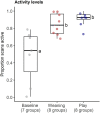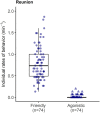Salivary Cortisol, but Not Oxytocin, Varies With Social Challenges in Domestic Pigs: Implications for Measuring Emotions
- PMID: 35677575
- PMCID: PMC9169876
- DOI: 10.3389/fnbeh.2022.899397
Salivary Cortisol, but Not Oxytocin, Varies With Social Challenges in Domestic Pigs: Implications for Measuring Emotions
Abstract
Animals respond to inherently rewarding or punishing stimuli with changes in core affective states, which can be investigated with the aid of appropriate biomarkers. In this study we evaluate salivary cortisol (sCORT) and salivary oxytocin (sOXT) concentrations under baseline conditions and in response to two negatively- and two positively-valenced social challenges in 75 young pigs (Sus scrofa domesticus), housed and tested in eight social groups. We predicted that: (1) Relative to baseline, weaning and brief social isolation would be associated with increases in sCORT, due to psychosocial stress, and reductions in sOXT, due to a lack of opportunities for social support; and (2) Opportunities for social play, and reunions with group members after a separation would be associated with weaker sCORT responses, and increases in sOXT concentrations compared to baseline and to negative social challenges. Testing and sample collection occurred between 28 and 65 days of age and involved a within-subject design, in which every subject was sampled multiple times in neutral (baseline), negative and positive social contexts. We also recorded behavioral data and measured rates of agonism, play and affiliative interactions in the different contexts, prior to saliva sampling. As expected, negative social challenges were associated with robust cortisol responses. Relative to baseline, pigs also had higher sCORT responses to positive social challenges, although these differences were only significant during reunions. Salivary oxytocin concentrations did not differ between the different social conditions, although sOXT was lowest during the brief social isolation. Behavioral analyses confirmed predictions about the expected changes in social interactions in different social contexts, with increases in agonism following weaning, increases in coordinated locomotor play in the play context and high rates of affiliative interactions during reunions. Relative sCORT reactivity to different contexts may reflect the intensity of emotional responses, with greater increases occurring in response to challenges that involve more psychosocial stress. Our results suggest that sOXT is not a reliable indicator of emotional valence in pigs, although more research is needed to characterize sOXT responses to various challenges with and without access to social support.
Keywords: Sus scrofa domesticus; emotions; non-invasive; physiology; play; reunions; social isolation; weaning.
Copyright © 2022 Moscovice, Gimsa, Otten and Eggert.
Conflict of interest statement
The authors declare that the research was conducted in the absence of any commercial or financial relationships that could be construed as a potential conflict of interest.
Figures






Similar articles
-
Changes in salivary oxytocin in response to biologically-relevant events in farm animals: method optimization and usefulness as a biomarker.Front Physiol. 2024 Mar 19;15:1370557. doi: 10.3389/fphys.2024.1370557. eCollection 2024. Front Physiol. 2024. PMID: 38567114 Free PMC article.
-
Group singing and its effect on cortisol, alpha amylase, oxytocin, and pain threshold in patients with Parkinson's disease.Front Neurosci. 2025 May 9;19:1569601. doi: 10.3389/fnins.2025.1569601. eCollection 2025. Front Neurosci. 2025. PMID: 40415897 Free PMC article.
-
Reduced salivary oxytocin after an empathic induction task in Intimate Partner Violence perpetrators: Importance of socio-affective functions and its impact on prosocial behavior.Psychoneuroendocrinology. 2022 Mar;137:105644. doi: 10.1016/j.psyneuen.2021.105644. Epub 2021 Dec 23. Psychoneuroendocrinology. 2022. PMID: 34979319
-
Meta-analysis of the effectiveness of the Trier Social Stress Test in eliciting physiological stress responses in children and adolescents.Psychoneuroendocrinology. 2020 Jun;116:104582. doi: 10.1016/j.psyneuen.2020.104582. Epub 2020 Jan 16. Psychoneuroendocrinology. 2020. PMID: 32305745 Review.
-
Endogenous peripheral oxytocin measures can give insight into the dynamics of social relationships: a review.Front Behav Neurosci. 2014 Mar 11;8:68. doi: 10.3389/fnbeh.2014.00068. eCollection 2014. Front Behav Neurosci. 2014. PMID: 24672442 Free PMC article. Review.
Cited by
-
Short Immobilization in a Sling Does Not Lead to Increased Salivary Cortisol Levels in Pigs.Animals (Basel). 2024 Sep 24;14(19):2760. doi: 10.3390/ani14192760. Animals (Basel). 2024. PMID: 39409709 Free PMC article.
-
Investigating the psychophysiological effects of NaiKan Therapy: salivary oxytocin and cortisol release.Front Integr Neurosci. 2025 Feb 25;19:1476654. doi: 10.3389/fnint.2025.1476654. eCollection 2025. Front Integr Neurosci. 2025. PMID: 40070797 Free PMC article.
-
Changes in salivary oxytocin in response to biologically-relevant events in farm animals: method optimization and usefulness as a biomarker.Front Physiol. 2024 Mar 19;15:1370557. doi: 10.3389/fphys.2024.1370557. eCollection 2024. Front Physiol. 2024. PMID: 38567114 Free PMC article.
-
Non-invasive methods for analysing pig welfare biomarkers.Vet Med (Praha). 2024 May 27;69(5):137-155. doi: 10.17221/17/2024-VETMED. eCollection 2024 May. Vet Med (Praha). 2024. PMID: 38841131 Free PMC article. Review.
-
Spontaneous helping in pigs is mediated by helper's social attention and distress signals of individuals in need.Proc Biol Sci. 2023 Aug 9;290(2004):20230665. doi: 10.1098/rspb.2023.0665. Epub 2023 Aug 2. Proc Biol Sci. 2023. PMID: 37528710 Free PMC article.
References
LinkOut - more resources
Full Text Sources
Research Materials

